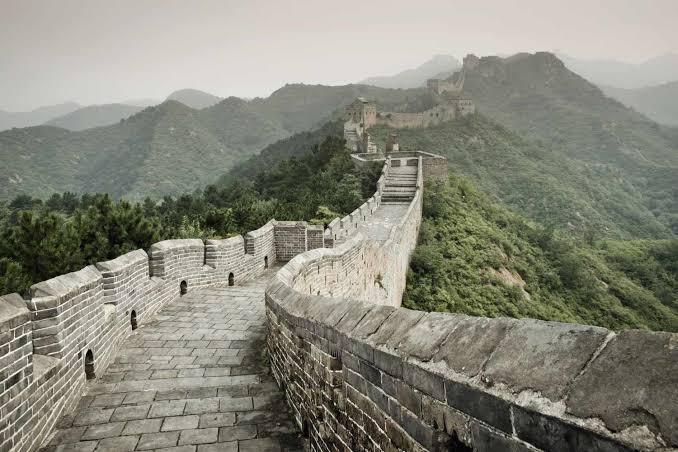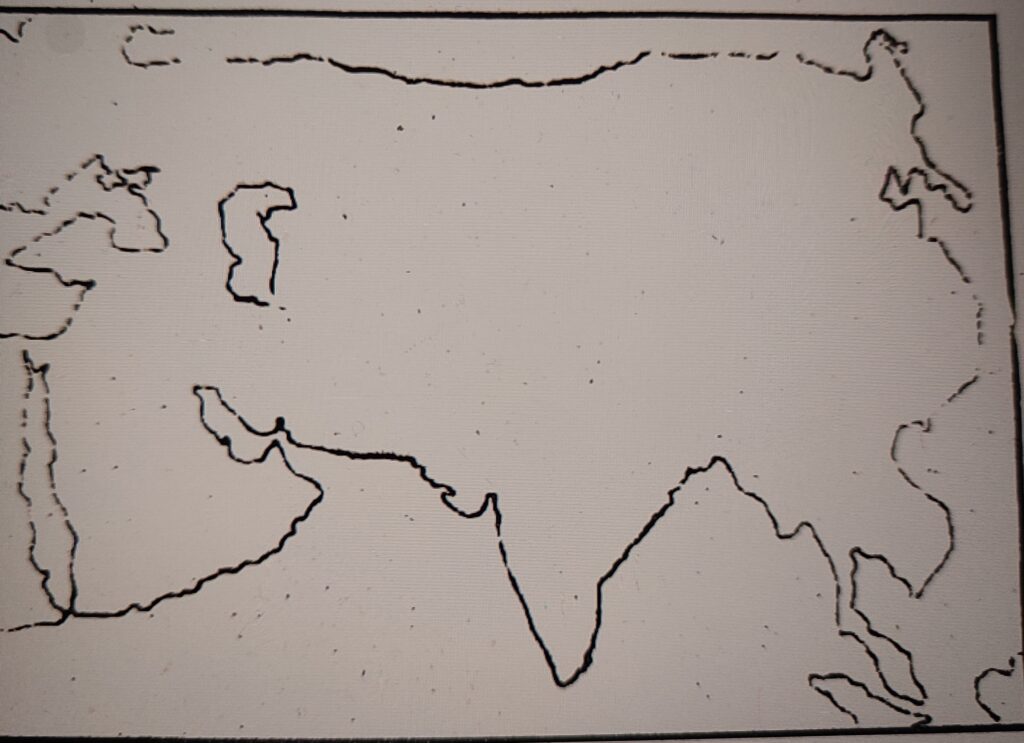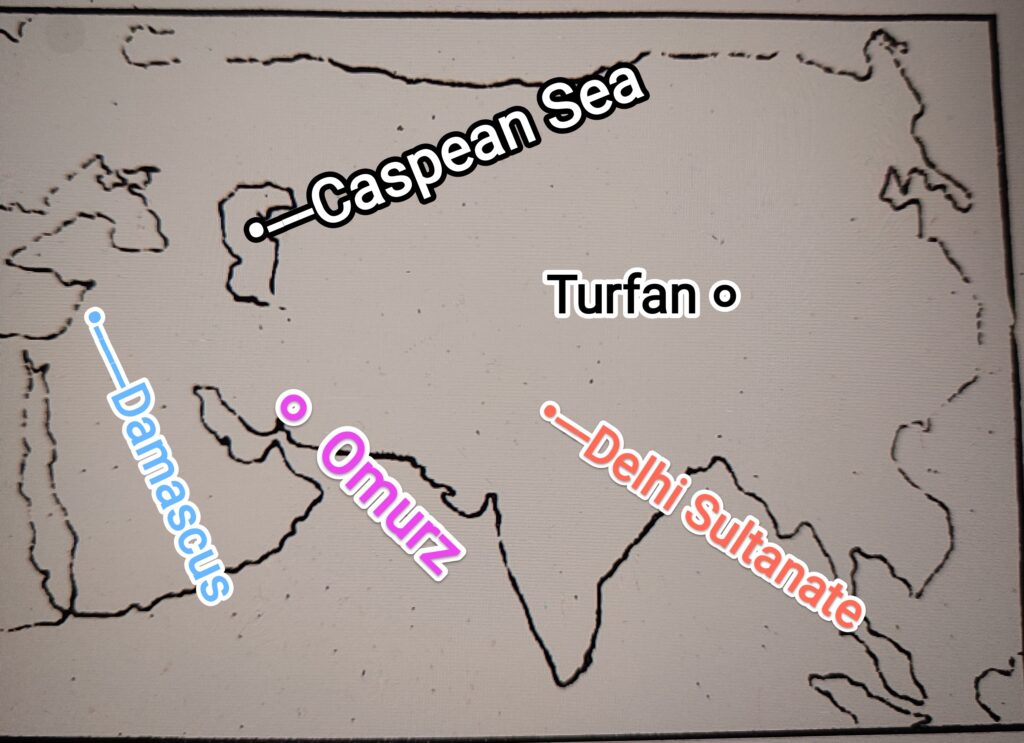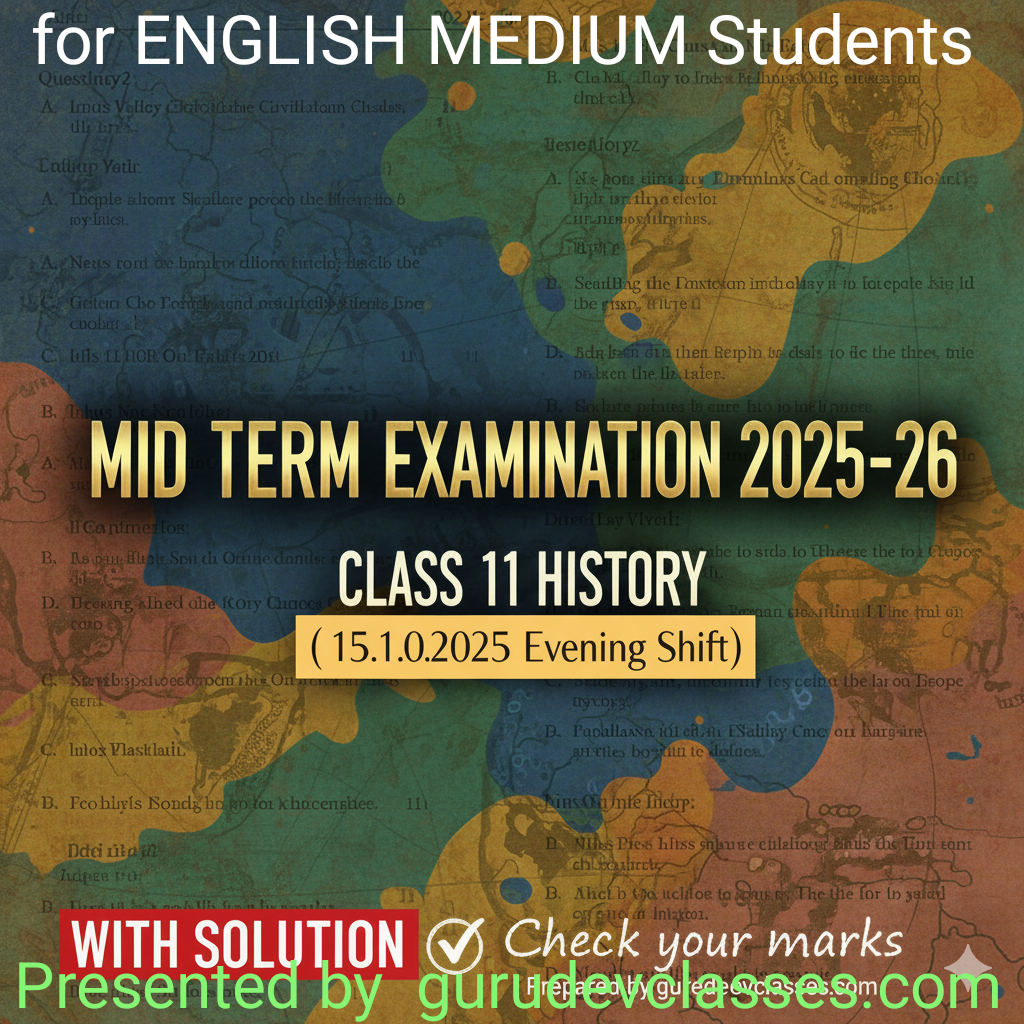Section A ( 1 Mark Multiple Choice Questions)
Q1. Which part of the Bible is called “Old Testament”?
(A) Third
(B) Second
(C) First
(D) Last
Answer: (C) First
Explanation:
The Old Testament is the first part of the Christian Bible. It contains Jewish scriptures written before the birth of Jesus Christ.
Q2. Which country is known as Asia-Minor?
(A) Turkey
(B) Irap
(C) Rome
(D) Iraq
Answer: (A) Turkey
Explanation:
Asia Minor (or Anatolia) refers to the large peninsula that today forms modern Turkey. It was a link between Asia and Europe.
Q3. ‘Temujin’ was the name of which Mongol ruler?
(A) Batu
(B) Genghis Khan
(C) Mongke
(D) Jochi
Answer: (B) Genghis Khan
Explanation:
Before becoming the great conqueror known as Genghis Khan (“Universal Ruler”), his original name was Temujin.
Q4. Which order was exempted from the direct tax called “Taille”?
(A) Clergy
(B) Nobility
(C) Peasantry
(D) Both Clergy and Nobility
Answer: (D) Both Clergy and Nobility
Explanation:
In medieval France, Taille was a direct tax paid only by peasants; the clergy and nobility were exempt.
Q5. Which geographical part of Mesopotamia was green and fertile?
(A) Northern
(B) Southern
(C) North-Eastern
(D) Western
Answer: (B) Southern
Explanation:
The Southern part of Mesopotamia had better rainfall, hills, and fertile land suitable for agriculture.
Q6. Spanish writer ‘Columella’ recommended the formation of groups of how many workers?
(A) 15
(B) 10
(C) 20
(D) 25
Answer: (B) 10
Explanation:
Roman writer Columella recommended forming groups of 10 workers for efficient agricultural work and supervision.
Q7. Feudalism better indicates the relationship between whom?
(A) Lord–Peasant
(B) Lord–Priest
(C) Peasant–Priest
(D) Lord–Knight
Answer: (D) Lord–Knight
Explanation:
Feudalism was based on land-for-service relationships. A lord granted land (fief) to a knight in return for military service.
Q8. The piece of land given by the Lord to the Knight was called –
(A) Tithe
(B) Taille
(C) Fief
(D) Parish
Answer: (C) Fief
Explanation:
A fief was a piece of land given by a lord to a vassal or knight as a reward for loyalty and service.
Q9. Match the Following:
Column-I _______Column-II
I. Campania____ a. Spain
II. Fayyum ______b. Syria
III. Baetica ______c. Italy
IV. Damascus ___d. Egypt
Options:
___l_ll_lll_lV
(A) a b c d
(B) b c a d
(C) d a b c
(D) c d a b
Answer: (D)l–c, ll–d, lll–a, lV–b
Explanation:
Campania → Italy
Fayyum → Egypt
Baetica → Spain
Damascus → Syria
Q10. Ashurbanipal was the ruler of –
(A) Babylon
(B) Assyria
(C) Sumer
(D) Akkad
Answer: (B) Assyria
Explanation:
Ashurbanipal (7th century BCE) was the last great king of Assyria, known for establishing the library of Nineveh.
Q11. The given image is related to which country?

(A) India
(B) China
(C) Mongolia
(D) Rome
Answer: (B) China
Explanation:
Images of the great wall of China.
Q12. Julius Caesar was related to which Empire?
(A) Iran
(B) Roman
(C) Egypt
(D) Mesopotamia
Answer: (B) Roman
Explanation:
Julius Caesar was a Roman general and statesman who played a major role in the transformation of the Roman Republic into Empire.
Q13. Assertion (A) and Reason (R)
Assertion (A): The literacy rate of the people of Mesopotamia was quite low.
Reason (R): In Mesopotamia, not only were the number of symbols or signs more, but they were also much more complex.
Options:
(A) Both (A) and (R) are true and (R) is the correct explanation of (A).
(B) Both (A) and (R) are true but (R) is not the correct explanation of (A).
(C) (A) is true and (R) is false.
(D) (A) is false and (R) is true.
Answer: (A) ✅
Explanation:
The cuneiform script used in Mesopotamia was very complex with many symbols, so very few people were literate.
Q14. Which relationship related to Genghis Khan is incorrect?
(A) Yesugei – Father
(B) Oelun-Eke – Mother
(C) Borte – Wife
(D) Jamuka – Uncle
Answer: (D) Jamuka – Uncle
Explanation:
Jamuka was Genghis Khan’s childhood friend and rival, not his uncle.
Q15. Which Roman ruler established the Principate?
(A) Caesar
(B) Justinian
(C) Tiberius
(D) Augustus
Answer: (D) Augustus
Explanation:
In 27 BCE, Emperor Augustus established the Principate, marking the beginning of the Roman Empire.
Q16. By the sixth century BCE, who had control over most of Assyria?
(A) Roman
(B) Iranian
(C) Greek
(D) Chinese
Answer: (B) Iranian
Explanation:
By the 6th century BCE, the Persian (Iranian) Empire under Cyrus the Great had conquered the Assyrian regions.
Q17. What kind of governance was there in the Roman Empire from 509 BCE to 27 BCE?
(A) Monarchy
(B) Republic
(C) Democracy
(D) Dictatorship
Answer: (B) Republic
Explanation:
Between 509 and 27 BCE, Rome was a Republic governed by the Senate and elected magistrates before the rise of the Empire.
Q18. Which metal came to Mesopotamia from “Alashiya,” the island of Cyprus?
(A) Copper
(B) Gold
(C) Silver
(D) Iron
Answer: (A) Copper
Explanation:
Alashiya (ancient Cyprus) was known for exporting copper, a key metal used in Mesopotamian tools and trade.
Q19. Where was Zimrilim’s Palace located?
(A) Uruk
(B) Babylon
(C) Akkad
(D) Mari
Answer: (D) Mari
Explanation:
King Zimrilim ruled from Mari, an ancient city on the Euphrates River, famous for its grand palace and archives.
Q20. What was Solidus in the Roman Empire?
(A) Container
(B) King
(C) Coin
(D) Animal
Answer: (C) Coin
Explanation:
The Solidus was a gold coin introduced by Emperor Constantine in the 4th century CE, widely used in trade.
Q21. What was the language of the historian “Herodotus”?
(A) Persian
(B) Greek
(C) Latin
(D) Hebrew
Answer: (B) Greek
Explanation:
Herodotus wrote his famous Histories in Greek, earning him the title “Father of History.”
Section B ( 3 Mark Short Answer type questions)
Q22. Explain about the geographical diversity of Mesopotamia.
Answer:
- Location: Mesopotamia, meaning “land between two rivers”, lay between the Tigris and Euphrates rivers in present-day Iraq.
- Regional Division: It was divided into Northern Mesopotamia (hilly and fertile due to rainfall) and Southern Mesopotamia (flat plains dependent on irrigation).
- Agricultural Richness: The river systems provided alluvial soil and irrigation, making the land ideal for agriculture and early urban settlements like Ur, Uruk, and Babylon.
OR
Shed light on the social life of Mesopotamia.
Answer:
- Hierarchical Society: Mesopotamian society was divided into classes — nobles, priests, merchants, artisans, farmers, and slaves.
- Patriarchal Family: Families were patriarchal, with the father as head; women managed homes but had limited rights.
- Cultural Life: People enjoyed music, games, and festivals; education was mainly for scribes who mastered cuneiform writing.
Q23. Why was ‘Ziggurat’ important in Mesopotamia?
Answer:
- Religious Centre: A Ziggurat was a temple tower built in honor of a city’s patron god or goddess.
- Symbol of Power: It showed the political and religious authority of kings who claimed divine support.
- Architectural Marvel: Ziggurats were multi-storied stepped structures, serving as both temple and administrative centers in cities like Ur and Babylon.
Q24. Describe the reasons for the ‘Crisis of the Third Century’.
Answer:
- Political Instability: Frequent changes of emperors and civil wars weakened central authority in the Roman Empire.
- Economic Decline: Heavy taxation, inflation, and disrupted trade led to financial crises.
- Military Pressure: Continuous barbarian invasions and the need for large armies drained the empire’s resources.
Q25. What was the status of women regarding property in the Roman Empire? Analyse.
Answer:
- Right to Inherit: Women could own and inherit property, especially after the decline of paterfamilias (male head’s authority).
- Wealthy Women’s Role: Many wealthy Roman women managed estates, businesses, and slaves independently.
- Limitations: Despite rights, women were still legally under male guardianship and had limited participation in politics.
Q26. Discuss the importance of the ‘Harkara System’ in the Mongol Empire.
Answer:
- Efficient Communication: The Harkara or Yam system was a relay postal network ensuring quick information flow across vast territories.
- Strategic Control: It helped the Mongols coordinate military movements and maintain administrative control.
- Infrastructure Development: Relay stations provided fresh horses, food, and shelter, promoting trade and governance efficiency.
Q27. What do you understand by ‘Manor Estate’? Describe its characteristics.
Answer:
- Definition: A Manor was a self-sufficient rural estate owned by a lord during the feudal age in medieval Europe.
- Economic Unit: It included farmland, peasant houses, church, and mill, where peasants worked for the lord.
- Features: Peasants provided labor and produce in exchange for protection; the manor was the center of rural life and economy.
OR
How were Knights related to the three classes? Examine.
Answer:
- Military Role: Knights belonged to the nobility class, trained for warfare and service under feudal lords.
- Service to Lords: They received fiefs (land) from lords in return for military service and loyalty.
- Link Between Classes: Knights acted as protectors of peasants and supporters of the clergy, thus connecting all three orders—nobility, clergy, and peasants.
Section C ( 8 Mark Long Answer type Questions)
28. What is the contribution of Mesopotamian Civilization to the world? Explain.
Answer:
The Mesopotamian Civilization, one of the earliest known civilizations, made several remarkable contributions that laid the foundation of modern society.
- Development of Writing (Cuneiform):
The Mesopotamians invented cuneiform writing around 3200 BCE on clay tablets — the world’s first written script, enabling record keeping, administration, and literature. - Mathematics and Astronomy:
They developed a sexagesimal (base-60) system used for time measurement (60 seconds, 60 minutes). They also created early calendars based on lunar cycles. - Urbanization:
Cities like Ur, Uruk, and Babylon were among the first urban centers with temples, markets, and administrative buildings — introducing the concept of organized urban planning. - Architecture and Engineering:
They built grand Ziggurats, canals, and walls. Their irrigation systems transformed arid plains into fertile lands. - Law and Governance:
The Code of Hammurabi, one of the earliest written legal systems, emphasized justice, property rights, and punishment, shaping later legal traditions. - Trade and Economy:
Mesopotamians traded with regions like Indus Valley, Egypt, and Anatolia, exchanging goods like metals, textiles, and grain, leading to international trade networks. - Art and Literature:
The Epic of Gilgamesh, the world’s earliest known epic poem, reflected their literary creativity and human values. - Religious and Scientific Ideas:
They worshipped many gods and developed early ideas about the cosmos, rituals, and astrology, influencing later civilizations.
Conclusion:
Mesopotamia’s achievements in writing, law, architecture, and science became the foundation of world civilization, marking it as the “Cradle of Civilization.”
OR
Evaluate the role of the king in the Urbanisation of Mesopotamia.
Answer:
The Mesopotamian king played a crucial role in the growth of cities and state organization.
- Central Authority:
The king was the political, military, and religious head, ensuring law and order in the city-state. - Irrigation and Agriculture:
Kings supervised canal construction and maintenance, which supported agriculture and food production, leading to population growth. - Temple Building:
Kings built Ziggurats and temples, which became centers of administration, religion, and trade — the heart of urban life. - Tax and Resource Management:
They collected taxes in the form of grain or labor, using them to fund construction, defense, and religious ceremonies. - Trade and Diplomacy:
Kings encouraged long-distance trade with foreign regions to secure raw materials like copper and timber, enhancing urban prosperity. - Law and Justice:
Kings like Hammurabi introduced legal codes ensuring justice and discipline, essential for city stability. - Military Protection:
Strong armies under royal command defended cities from invasions, ensuring the safety needed for urban development. - Symbol of Unity:
The king represented divine authority, uniting diverse city populations under one administrative system.
Conclusion:
Thus, the Mesopotamian king was central to the process of urbanization, combining political power, economic management, and religious legitimacy.
29. Genghis Khan was a great Military Commander. Justify the statement with valid arguments. (8 Marks)
Answer:
Genghis Khan (Temujin), the founder of the Mongol Empire, is remembered as one of history’s most outstanding military leaders.
- Unification of Tribes:
He united the Mongol tribes under a single banner through leadership, diplomacy, and strategic marriages, ending tribal conflicts. - Superior Military Organization:
He organized the army into units of 10, 100, 1,000, and 10,000, ensuring discipline and quick mobilization. - Use of Cavalry:
The Mongol cavalry was highly mobile, skilled in archery and horse-riding, allowing them to strike swiftly and retreat strategically. - Effective Communication System (Yam System):
The Harkara or Yam system ensured rapid communication, enabling coordinated military operations across vast distances. - Psychological Warfare:
Genghis Khan used fear and terror tactics, spreading panic among enemies before battles, which often led to surrender without resistance. - Merit-Based Promotion:
Soldiers were promoted on the basis of merit, loyalty, and skill, not birth — ensuring efficiency and motivation. - Adaptation and Innovation:
He adopted new weapons and siege techniques from conquered lands, such as Chinese gunpowder and Persian engineering. - Global Conquests:
Under his leadership, the Mongols conquered vast territories — China, Central Asia, Persia, and parts of Russia, forming the largest contiguous empire in history.
Conclusion:
Genghis Khan’s strategic vision, organizational skills, and leadership made him a legendary military commander, whose empire reshaped Eurasian history.
OR
Why was trade so important for the Mongols? State reasons.
Answer:
Trade was vital for the Mongol Empire’s strength and stability.
- Nomadic Economy:
The Mongols lived in pastoral regions with few natural resources, making trade essential for obtaining goods like silk, spices, and metals. - Economic Prosperity:
Trade brought revenue and wealth, funding armies and administration. - Promotion of Silk Route:
Genghis Khan and his successors revived and protected the Silk Route, connecting China to Europe for commerce and culture. - Diplomatic Relations:
Trade encouraged peaceful ties with neighboring states, increasing political influence. - Spread of Culture and Technology:
Trade facilitated the exchange of knowledge, inventions, and religions across Asia and Europe. - Postal and Road Network:
The Yam system ensured safe travel for merchants, increasing trade efficiency and security. - Tax Revenue:
The Mongol rulers collected customs and trade taxes, strengthening the imperial treasury. - Empire Integration:
Trade connected distant provinces, promoting unity and interdependence within the vast empire.
Conclusion:
For the Mongols, trade was not merely economic but a pillar of empire-building, diplomacy, and cultural exchange.
30. How did ‘Feudalism’ affect medieval Europe? Analyse. (8 Marks)
Answer:
Feudalism was the political and economic system of medieval Europe (9th–15th centuries) based on land, loyalty, and service.
- Political Decentralization:
Kings distributed land to nobles and lords, leading to local control and weakened central authority. - Manorial System:
Each manor became self-sufficient, producing food and goods, forming the base of the rural economy. - Social Hierarchy:
Society was divided into three main classes — nobles, clergy, and peasants — with limited social mobility. - Land-Based Economy:
Land was the main source of wealth and power, determining one’s rank in society. - Military Protection:
Lords maintained knights who protected the land in return for fiefs (land grants). - Limited Trade and Urban Growth:
The focus on agriculture led to slow development of trade and towns during early medieval times. - Church Influence:
The Church owned vast lands and influenced both feudal lords and peasants, becoming a major political power. - Foundation for Modern States:
Feudal bonds eventually evolved into centralized monarchies, paving the way for the rise of modern Europe.
Conclusion:
Feudalism shaped Europe’s political, economic, and social order, providing stability but also limiting growth until its decline after the 14th century.
OR
Who were monks in Europe? Describe their social and religious life in detail.
Answer:
Monks were members of religious communities who devoted their lives to spirituality, prayer, and service in medieval Europe.
- Religious Vocation:
Monks lived under strict rules in monasteries, dedicating their lives to God, prayer, and discipline. - Founder Influence:
The Benedictine Rule (by St. Benedict) guided monastic life — emphasizing poverty, obedience, and manual labor. - Daily Life:
Their day was divided between prayer (eight times daily), study, and work like farming or copying manuscripts. - Centers of Learning:
Monasteries preserved ancient manuscripts and became educational centers for Europe’s scholars. - Economic Role:
Monks cultivated land, managed estates, and introduced new agricultural techniques, contributing to rural development. - Social Services:
Monks provided food, shelter, and medical care to travelers and the poor, acting as centers of charity. - Spiritual Guidance:
They inspired the public through moral discipline and religious instruction, strengthening the Church’s influence. - Cultural Contribution:
Monks’ writings, art, and architecture enriched European literature, education, and culture.
Conclusion:
Medieval monks played a vital role in preserving faith, knowledge, and culture, serving as the spiritual and intellectual backbone of Europe.
Section D (Case study)
On the Treatment of Slaves
‘Soon afterwards the City Prefect, Lucius Pedanius Secundus, was murdered by one of his slaves. After the murder, ancient custom required that every slave residing under the same roof must be executed. But a crowd gathered, eager to save so many innocent lives, and rioting began. The senate-house was besieged. Inside, there was feeling against excessive severity, but the majority opposed any change (…) [The senators] favouring execution prevailed. However, great crowds ready with stones and torches prevented the order from being carried out. Nero rebuked the population by edict, and lined with troops the whole route along which those condemned were taken for execution.”
-Tacitus (55-117), historian of the early empire.
Q31.1 Which rater was assassinated? (1)
Answer: Lucius Pedanius Secundus was assassinated.
Q31.2 In whose edict people were reprimanded? (1)
Answer: People were reprimanded in the edict of Emperor Nero.
Q31.3 What was the reason for the disagreement among the senators? (2)
Answer: Some senators opposed executing all slaves because many were innocent.
Others supported strict punishment to maintain discipline and the authority of Roman law.
Hence, the disagreement arose between leniency and strict adherence to tradition.
Q32. Read the following source carefully and Answers the Question that follow
The Capture of Bukhara
Mwain, a late-thirteenth-century Persian chronicler of the Mongol rulers of tean, curied an account of the capture of thikhara in 1220. After the conquest of the city, uwnini reported Genghis Khan went to the Bestival ground where the rich residents of the city were and addressed them: O people knew that you have committed great sins, and that the great cres among you have committed these sins. If you ask me what proof I have for these words, I say it is because I am the punishment of God. If you had not committed great sins, God weall not have sent a punishment like me upon you’ New one man had escaped from Bukhara after its capture and had come to Khurasan. He was questioned about the fate of the city and replied: “They came, they (mined the walls), they bunt, they slew, they phundered and they departed.”
Q32.1 be which country ‘Bukhara’ is situated?(1)
Answer: Bukhara is situated in Uzbekistan.
Q32.2 Whom did God send for punishment?(1)
Answer: God sent Genghis Khan as punishment.
Q32.3 How did the mongal ruler punish the residents?(2)
Answer: The Mongols destroyed the walls of Bukhara.
They burnt and looted the city.
They killed many people and left it in ruins.
Thus, Bukhara was completely devastated by Genghis Khan’s army.
Q33. Read the following source carefully and Answers the Question that follow:
“When in April the sweet showers full And pierce the drought of March to the root
And the small birds are making melody
That sleep away the night with open eye…
(So Nature pricks them and their heart engages);
Then people long to go on pilgrimages, And palmers long to seek the foreign shrines
Of far-off saints, revered in various lands.
And especially from every shire
Of England, to Canterbury they make their journey
Q33.1 To whom this poem is related?(1)
Answer: This poem is related to Geoffrey Chaucer’s ‘The Canterbury Tales’.
Q33.2 Why did the monks go to Canterbury?( 1)
Answer: The monks went to Canterbury to visit the shrine of Saint Thomas Becket, a famous saint of England.
Q33.3 Where did the monks get inspiration for the pilgrimage? Give examples.(2)
Answer: They were inspired by religious devotion and nature’s renewal in spring.
The poem mentions how “sweet April showers” and the awakening of nature encouraged people to travel and seek blessings.
Example: Pilgrims from different “shires of England” journeyed to the holy shrine out of faith.
Section E: Map based Questions
Q34. On the given outline map of Mongol Empire, Locate and label the following places with appropriate symbols.

- Delhi Sultanate
- Damascus
- Turfan
- Caspean sea
- Omurz

NOTE: The following questions are only for Visually Impaired Candidates in lieu of question No. 34.
Q34. 1. Which river was called the lifeline of Mesopotamia? (1)
Answer: The Euphrates and the Tigris Rivers were called the lifelines of Mesopotamia.
Explanation: Mesopotamia means “land between two rivers” — it flourished between the Tigris and Euphrates, which provided water for irrigation, transport, and agriculture.
Q34. 2. What was ‘Principate’?
Answer: The Principate was the form of government established by Augustus in Rome in 27 BCE.
Explanation:
Under the Principate, the emperor called himself Princeps (first citizen) and exercised supreme power while maintaining the outward appearance of a Republic.
Q34. 3. What was ‘Panja’ in the Mongol Empire?
Answer: ‘Panja’ was a military unit or division in the Mongol army.
Explanation: The Mongols organized their army on a decimal system — units of 10 (arban), 100 (jagun), 1,000 (mingan), and 10,000 (tumen). The panja referred to one of these organized groups responsible for discipline and control.
Q34. 4. To the south of which sea is Constantinople located?
Answer: Constantinople is located to the south of the Black Sea.
Explanation: Situated on the Bosporus Strait, Constantinople (modern Istanbul) lies between the Black Sea (north) and the Sea of Marmara (south).
Q34. 5. To the east of which sea is ‘Antioch’?
Answer: Antioch is located to the east of the Mediterranean Sea.
Explanation:
Ancient Antioch (modern Antakya in Turkey) was a major city near the northeastern coast of the Mediterranean, giving it great trade and cultural importance.







